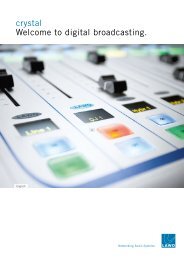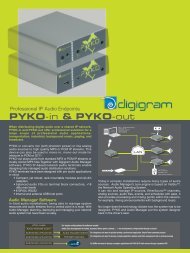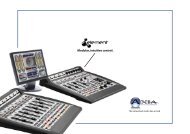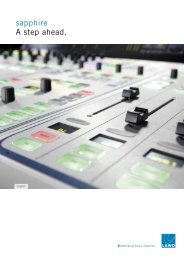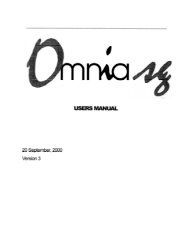Digigram PCXpocket
Digigram PCXpocket
Digigram PCXpocket
- No tags were found...
Create successful ePaper yourself
Turn your PDF publications into a flip-book with our unique Google optimized e-Paper software.
D i g i g r a m<strong>Digigram</strong> <strong>PCXpocket</strong>Laptop Sound CardsPROFESSIONAL AUDIO APPLICATIONS ON YOUR LAPTOPy IN 1997, DIGIGRAM PCXPOCKET was the first Type II PCCard for professional audio applications on a laptop.<strong>Digigram</strong> now offers you a choice Pocket cards witha range of processing power levels and audiointerface configurations.The three <strong>Digigram</strong> <strong>PCXpocket</strong> cards are designedprimarily for specialized <strong>Digigram</strong> Poweredapplications that are written by our developmentpartners to run on the cards’ on-board digital signalprocessors.For standard third-party audio and music productionsoftware on Windows or Mac OS platforms, the<strong>Digigram</strong> VXpocket (described separately) should beconsidered.■ The <strong>PCXpocket</strong> v3 has both analog and digitalinputs and outputs.■ <strong>PCXpocket</strong> 240 and <strong>PCXpocket</strong> 440 arededicated for multichannel applications.If the possibility of running sophisticated audioapplications on a laptop has sparked yourimagination, this range of cards can turn yourconcept into a reality.<strong>Digigram</strong> <strong>PCXpocket</strong>Laptop Sound Cards
D i g i g r a myKEY FEATURES■ All cards are full duplex, offering simultaneous andindependent record and playback capabilities.■ PCM encoding/decoding resolutions are 8, 16, or 24bits.■ All Pocket cards can run applications that complywith Microsoft’s WAVE protocol.■ When using applications based on the <strong>Digigram</strong> npSDK with the <strong>PCXpocket</strong> cards:■ Real-time mixing of multiple sound files, leveladjustment, panning, cross fade, punch-in/punchout,scrubbing, time-stretching, pitch-shifting, andformat and frequency conversions are performedon the DSP of the cards.■ Cards perform real-time, simultaneous MPEGLayer I and Layer II compression anddecompression during record and playback.Support provided for Layers I and II of the MPEGAudio standard (ISO 11172-3) and the lowsampling frequencies of the MPEG-2 Audiostandard (ISO 13818-3).■ Cards perform GSM encoding and decoding.■ LTC inputs on the <strong>PCXpocket</strong> v3 and <strong>PCXpocket</strong>440 can be used for synchronization.■ Multiple applications may share the resources of asingle card.■ Analog inputs and outputs may be configured asone stereo or two mono channels.■ Interboard synchronization is possible foroperation of two <strong>PCXpocket</strong> 440s in one laptop.<strong>PCXpocket</strong> v3Our latest generation stereo model, the <strong>PCXpocket</strong> v3provides the finest portable audio quality with its 24-bitconverters. Significant on-board DSP enables the<strong>PCXpocket</strong> v3 to manage a variety of <strong>Digigram</strong> Powered(np SDK) applications, including those that can takeadvantage of its LTC (SMPTE) time-code input forsynchronization.These applications can perform their audioprocessing on the <strong>PCXpocket</strong> v3, instead of on thecomputer’s native processor.The <strong>PCXpocket</strong> v3 is also compatible with the wide rangeof PC software for recording and production that operateunder Microsoft’s WAVE protocol and run on the laptop’sprocessor. It has two balanced analog mono inputs atmicrophone or line level and two balanced analog outputs.SPDIF input and output allow direct digital transfer.A breakoutcable is provided with XLR connectors for the analoginputs/outputs, phono (CINCH) connectors for the digitalinput/output, and a phono connector for the LTC input.<strong>Digigram</strong> <strong>PCXpocket</strong>Laptop Sound Cards
D i g i g r a m<strong>PCXpocket</strong> 240Primarily designed for low bit rate recording applications,such as audio logging, the <strong>PCXpocket</strong> 240 has four balancedanalog mono inputs and a stereo output for monitoring.Inputs can operate at microphone or line level.When usingan application developed using the np SDK, MPEG (Layer Ior II) or GSM coding is performed on the card’s DSP formaximum recording time. PCM linear is also available forbest fidelity in audio analysis and other uses. DSP-basedprocessing, such as scrubbing, adds to the card’s flexiblefeature set.A unique “Cable Cosse” provides positive connection tothe PC Card on one side and to a fan-out of audio cableson the other. Input connectors are XLR and the outputconnector is a stereo phone jack.Applications using Microsoft’s WAVE API may also be usedwith the <strong>PCXpocket</strong> 240.<strong>PCXpocket</strong> 440<strong>Digigram</strong> is pleased to present our most complete laptopsound card The <strong>PCXpocket</strong> 440 has four mono (or twostereo) analog inputs and four mono (or two stereo) analogoutputs. In addition, an SPDIF input can be used in place ofthe first stereo input pair and an SPDIF output operates inparallel with the first stereo output pair. If more inputs andoutputs are needed, two <strong>PCXpocket</strong> 440s can besynchronized in the same laptop.Significant on-board DSP enables the <strong>PCXpocket</strong> 440 tomanage a variety of <strong>Digigram</strong> Powered(np SDK) applications, including those that can takeadvantage of its LTC (SMPTE) time-code input forsynchronization.Additional DSP functions enabled by the npSDK include MPEG (Layer I and II) and GSM encoding anddecoding, variable sampling frequency, and sophisticatedaudio processing. The <strong>PCXpocket</strong> 440 may also be usedwith applications using Microsoft’s WAVE protocol.A unique “Cable Cosse” provides positive connection tothe PC Card on one side and to a fan-out of audio cableson the other.Analog connectors are XLR and the SPDIF andLTC connectors are phono (CINCH).A portable and powerful digital audio workstation iscreated when the <strong>PCXpocket</strong> 440 is coupled with<strong>Digigram</strong>’s Xtrack suite of digital audio production tools.<strong>Digigram</strong> <strong>PCXpocket</strong>Laptop Sound Cards
ySPECIFICATIONSD i g i g r a m<strong>Digigram</strong> <strong>PCXpocket</strong>Laptop Sound CardsCONFIGURATION <strong>PCXpocket</strong> v3 <strong>PCXpocket</strong> 240 <strong>PCXpocket</strong> 440Bus/Format PC Card PC Card PC CardDigital Signal processor 56303 at 66 MHz 56303 at 80 MHz 56303 at 80 MHzRAM 128 kWords 128 kWords 128 kWordsSize Type II PC Card Type II PC Card Type II PC CardPower consumption, power on (5 V) 400 mA 450 mA 450 mAPower consumption, power off (5 V) 10kMicrophone input gain +26 dB or 47 dB +26 dB or 47 dB +26 dB or 47 dBDigital inputs (stereo) 1 SPDIF - 1 SPDIFOther inputs LTC (SMPTE) - LTC (SMPTE)Analog outputs (stereo) 1 balanced 1 unbalanced 2 balancedMaximum output/impedance +10 dBu/low impedance +4 dBu/low impedance +10 dBu/low impedanceProgrammable output level digital and analog digital and analog digital and analogDigital outputs (stereo) 1 SPDIF - 1 SPDIFAccess to main status bits of digital frame yes - yesAES11 synchronization yes - yesConnectors XLR for analog audio XLR for inputs XLR for analog audiophono CINCH for others phone jack for outputs phono CINCH for othersAUDIO SPECIFICATIONSSampling frequencies available Adjustable 8 to 48 kHz 48, 44.1, 32, 24, 22.05, Adjustable 8 to 48 kHzby 100 Hz steps 16, 11.025. 8 kHz by 100 Hz stepsA/D and D/A converter resolutions 24 bit 24 bit 24 bitFrequency response at 48 kHz (record + play on duplex cards) 20 Hz - 20 kHz: ±0.15 dB 20 Hz - 20 kHz: ±0.15 dB 20 Hz - 20 kHz: ±0.15 dBSignal to noise ratio (unweighted) >94 dB >93 dB >93 dBDistortion + noise at 1 kHz (record + play)





